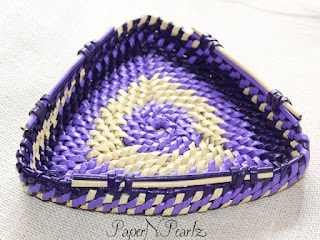This time of coronavirus has meant that I have received very few orders for my newspaper weaves during this year. But well, there is always a silver lining - I was able to work on my weaves, experiment with colours, try out new weaving techniques...
Let me assure you, trying to achieve a certain level of mastery in anything is difficult. While perfection is impossible to achieve - practice definitely does not make perfect, but it sure does make one better - striving towards that perfection, for me, is key to success. As far as my weaving goes, this means a lot of hours, plenty of effort and boat loads of experiments!
So time of quarantine has been that opportunity for me to
better my work. I have done a ton of reading (a lot of sites in other
languages, so thank you, Google Translate!!), a whole bunch of research,
hours of video-watching, many, many experiments with colours,
techniques, designs and rolling so many newspaper tubes that I can
probably do it blind-folded now!
And the result? Now I can say
that my work has definitely improved. In the next few months I will
be able to show that on my blog too. And hopefully, I would love to share some of my learning and if you are interested in paper weaving, I am sure that would benefit you.
Coming to this big box - this is one of the biggest projects I have had the pleasure to work on. The client wanted something to store toys in, something in pleasing pastel colours and something with a lid. She also wanted decoupage. That was all the requirements. And what a pleasure it has been!
I worked based on the patterns on the decoupage tissue - roses in pale peach. So my chosen colours were peach and white. This project involved a loooot of tube-rolling!! 😅😅 I started with a cardboard base, with decoupage done on that cardboard. The weaving was pretty straight-forward - the lower half was an experiment in random combinations of peach and white and the upper half was completely done in white. I absolutely loved the lid, with its little peach knob! Initially I had thought of adding a wooden know, but am quite happy I went with this paper knob instead.
Decoupage is quite interesting, but I think this will also take a back seat to the actual weaving. I love the way it accentuates the beauty of the box though.
Overall, a wonderful project and a pleased client 👍😀


























































